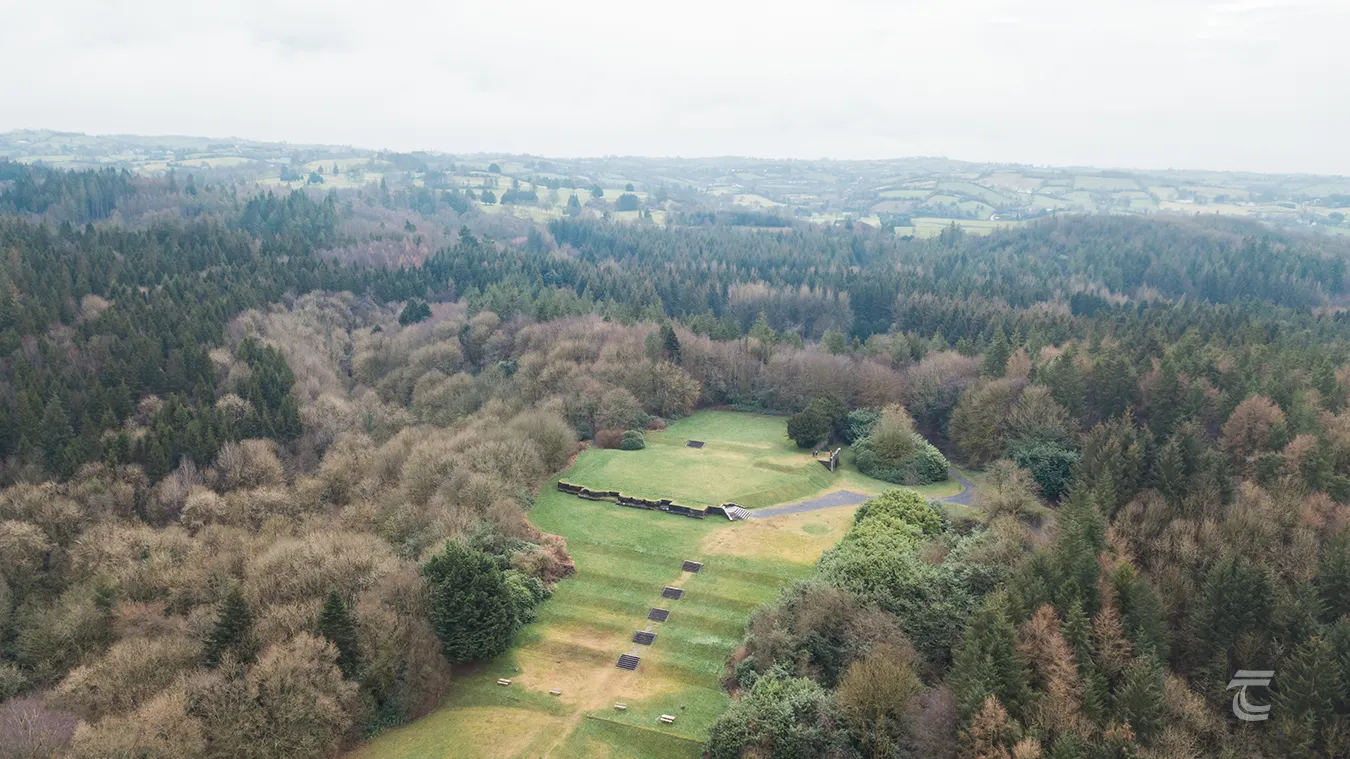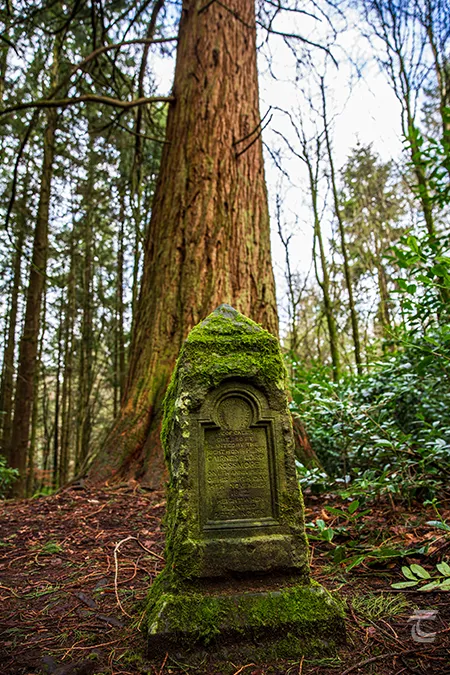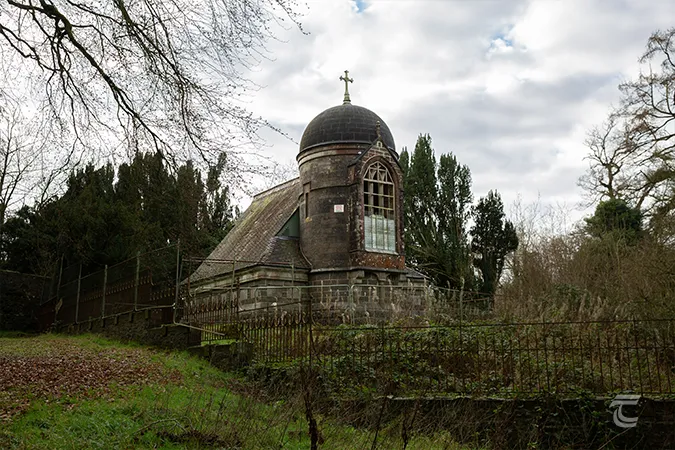Rossmore Forest Park
Rossmore Forest Park was once the seat of the Barons of Rossmore, and though there is little to be seen of the once grand Rossmore Castle, the estate still holds many hints of former splendour. Today the forest park has become a popular recreational amenity for the people of nearby Monaghan Town, its paths and trails frequented by dog walkers and families. Like many of our historic estates, the land has been parcelled up and divided with commercial forestry plantation and a golf course, though the walking trails through the forest park is still a highly rewarding experience.
You can discover more than 5,000 years of history at Rossmore Forest Park. Evidence for this extensive history can be found in the form of at least two megalithic tombs that have been recorded within the grounds. One of these, a court tomb, is hidden away in the forestry around 100–150m south-east of Barn Hill Lough. The tomb is largely overgrown and is extremely difficult to make out so it is easily missed. More evidence of the importance of this area during prehistory came to light in 1930 when a beautiful gold collar known as a lunula was discovered. These magnificent collars date to around 2000 BC in the early Bronze Age, and are made from sheets of gold beaten thin and intricately decorated. You can hear more about them from the leading expert in Ireland’s prehistoric gold, Mary Cahill, in this fascinating episode of Amplify Archaeology Podcast.
In the 17th century, the land that now encompasses Rossmore Park was owned by the Blayney family. However, during the turbulent years of the 17th century the fortunes turned sour for the Blayney family. The Irish Confederacy Rebellion of 1641 in particular proved catastrophic in many ways, especially when the 2nd Baron Blayney was killed in 1646, while fighting the Irish Confederates at the Battle of Benburb. The losses led to the Blayney family selling their land in the area to Alexander Cairns. The lands eventually passed through marriage to the Cuninghames, who became the Barons of Rossmore.
For practical information about visiting this site Click Here

Aerial view of the site of Rossmore Castle in Rossmore Forest Park • Monaghan
The History of Rossmore Castle

The giant redwood planted by the ‘Right Hon. Henry Cairns Lord Rossmore on the 11th Anniversary of his Birthday 14th November 1862’ • Rossmore Forest Park
The family originally lived in a house on the estate known as Cortolvin Hills. By the 18th century, the house was already well over a century old. It was described by the 3rd Baron Rossmore as ‘a paltry cabin, unfurnished and mean’. It would never do for an up-and-coming family like the Cuninghames, and plans were drawn up to construct a grand house in the fashionable Tudor-Gothic style by William Vitruvius Morrison. He was from a family of renowned architects from our hometown of Clonmel, Tipperary, and was involved in a number of famous designs, including Fota House in Cork, Ballyfin in Laois, Kilruddery in Wicklow and Baronscourt in County Tyrone, as well as public buildings like Wicklow Gaol and Carlow Courthouse. His design for Rossmore Castle featured a large tower, replete with elaborate turrets and battlements. Though the architecture of the castle significantly changed from 1858 onwards when a competition began between Lord Rossmore and Mr Shirley of Lough Fea over who had the largest room in County Monaghan. By the end of this competition Rossmore’s drawing room was enlarged five times and the castle contained three towers and 117 windows in 53 different shapes and sizes.
Rossmore Castle and its beautiful parkland were inherited by the 4th Lord Rossmore who died in 1874 during a steeplechase in Windsor Castle. A memorial in Monaghan town centre and a mausoleum in Rossmore Forest were built by Edward Tarver. The mausoleum was said to be ‘so beautiful that it made one in love with death’. Today, though it has fallen into some disrepair, it is still a truly beautiful structure and set in a tranquil and quiet part of the Forest Park off the main trails.
Like many grand houses in the 20th century, Rossmore Castle fell into decline, with dry rot eating away at the structure. The estate lands were broken up by the Land Commission and distributed between local farmers and the Forestry Division. The mausoleum was badly damaged and the long abandoned Rossmore Castle was demolished by the Army in 1974 due to health and safety concerns.

The giant redwood planted by the ‘Right Hon. Henry Cairns Lord Rossmore on the 11th Anniversary of his Birthday 14th November 1862’ • Rossmore Forest Park
Today much of the parkland survives with its eight lakes (Twin Lakes, Barnhill Lake, Castle Lake, Priestfield Lake, Ardaghy Lake, Steenson’s Lake, Bartle’s Lake). As a former grand estate, there are lots of exotic plants and trees and features to discover as you walk the trails. Yew trees and rhododendrons, bamboo, red woods, birch along with many native trees, and mallards, squirrels, foxes and badgers all call Rossmore Forest Park home. One of the most famous residents of the park is the Giant Redwood tree which was planted here by Henry Cairnes Westernra, 4th Lord Rossmore on his 11th birthday in 1862. Unfortunately Henry died at the young age of twenty two during a steeplechase in Windsor Castle in 1874. The death was witnessed by Queen Victoria who called off the races the next day as a mark of respect. Recently, this redwood won the Tree of the Year competition, which is run by the Tree Council of Ireland, in association with the Irish Tree Society.
All that remains of Rossmore Castle itself is the grand flight of steps that leads up to the area where the castle once stood. Below this is an elaborate structure known locally as ‘the ice-house’, though it is more likely the entrance to a servants’ tunnel to allow workers and supplies to be discreetly moved unobtrusively in and out of the castle. The remains of a walled garden can also be found nearby, and members of the Friends of Rossmore have undertaken conservation and restoration works on the Gardener’s Shed. The park has recently introduced the Giant’s playground, an excellent and imaginative space for children to play on natural materials.
The Rossmore Banshee
The death of Robert Cuninghame, 1st Baron Rossmore, gives us one of our earliest written accounts of the Banshee. This was recorded by Sir Jonah Barrington, who along with his wife Lady Barrington, was visiting Baron Rossmore in 1801. At this time, Baron Rossmore was 75 years old, though in ‘excellent health and good spirits’. He was married, though he and his wife had no children.
‘We retired to our bed-chamber about twelve, and towards two in the morning, I was awakened by a sound of a very extraordinary nature – I listened – it occurred first at short intervals, it neither resembled a voice or an instrument–it was softer than any voice, and wilder than any music, and seemed to float in the air… the sound became still more plaintive, till it almost died away in the air, when a sudden change, as if excited by a pang, changed its tone; it seemed descending. I felt every nerve tremble – it was not a natural sound, nor could I make out the point from whence it came; at length I awakened Lady Barrington, who heard it as well as myself… We now went to a large window in our bed-room, which looked directly into a small garden underneath–the sound seemed then obviously to ascend from a grass-plot, immediately below our window – it continued. Lady Barrington requested that I would call up her maid, which I did, and she was evidently more affected than either of us. The sounds lasted for more than half an hour-at last a deep heavy throbbing sigh, seemed to issue from the spot, and was shortly succeeded by a sharp low cry, and by the distinct exclamation, thrice repeated, of Rossmore, Rossmore, Rossmore!
I will not attempt to describe my own feelings; I cannot, indeed. The maid fled in horror from the window, and it was with difficulty I persuaded my wife to return to bed. In about a minute after, the sound died gradually away, and all was silent… About seven the ensuing morning, a strong rap at my chamber- door awakened me… I went to the door, when my faithful servant, Lawler, exclaimed on the other side, ‘ 0 Lord, Sir !’ ‘ What is the matter?’ said I, hurriedly-‘ Oh, Sir !’ exclaimed he, ‘Lord Rossmore’s footman was running past the door in great haste, and told me in passing, that my Lord after coming from the Castle, had gone to bed in perfect health, but that about half after two this morning, his own man, hearing a noise in his master’s bed, (he slept in the same room) went to him and found him in the agonies of death, and before he could alarm the other servants all was over.’ I conjecture nothing, I only relate the incident as unequivocally matter of fact. Lord Rossmore was absolutely dying at the moment I heard his name pronounced – let sceptics draw their own conclusions; perhaps natural causes
may be assigned, but I am totally unequal to the task.”’
Upper left: the mausoleum • Lower left: the structure known as the Ice House, but more likely a servants’ tunnel • Right: a giant’s head in the playground
Top: the mausoleum • Middle: a giant’s head in the playground • Bottom: the structure known as the Ice House, but more likely a servant’s tunnel
Rossmore Forest Park Visitor Information
Now a popular amenity outside the town of Monaghan, there is much to discover hidden in the trees of Rossmore Forest Park.
Explore more sites in Ireland’s Hidden Heartlands


